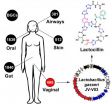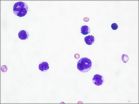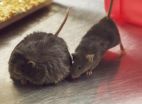(Press-News.org) Bacteria that normally live in and upon us have genetic blueprints that enable them to make thousands of molecules that act like drugs, and some of these molecules might serve as the basis for new human therapeutics, according to UC San Francisco researchers who report their new discoveries in the September 11, 2014 issue of Cell.
The scientists purified and solved the structure of one of the molecules they identified, an antibiotic they named lactocillin, which is made by a common bacterial species, Lactobacillus gasseri, found in the microbial community within the vagina. The antibiotic is closely related to others already being tested clinically by pharmaceutical companies. Lactocillin kills several vaginal bacterial pathogens, but spares species known to harmlessly dwell in the vagina.
This example suggests that there may be an important role for many naturally occurring drugs – made by our own microbes -- in maintaining human health, said the senior author of the study, Michael Fischbach, PhD, an assistant professor of bioengineering with the UCSF School of Pharmacy, who has established a career discovering interesting molecules made by microbes.
"We used to think that drugs were developed by drug companies, approved by the FDA, and prescribed by physicians, but we now think there are many drugs of equal potency and specificity being produced by the human microbiota," Fischbach said.
About a third of all medicines used in the clinic are derived from microbes and plants, Fischbach said. These include antibiotics like penicillin, numerous drugs used in cancer chemotherapy, and cholesterol-lowering drugs. Although those who prospect for drugs from microbes have been combing the depths of the oceans and probing exotic soils around the globe, only now have scientists begun to look within our own bodies.
There are hundreds of bacterial species associated with each of us, and thousands of distinct strains among them. We do not all harbor the same species, and different species are found at different body sites.
Through research funded by the National Institutes of Health's Human Microbiome Project and other studies, scientists in recent years have begun to describe the microbiomes – ecosystems made up of many microbial species – found in the gut, skin, nasal passages, mouth and vagina.
They have started to identify microbiomes in which species diversity and abundance differ from the normal range in ways that are associated with disease risks. However, the identification of molecules that govern interactions between microbes and their human hosts has lagged; only a handful have been identified, Fischbach said.
By developing new data-analysis software and putting it to work on an extensive genetic database developed from human-associated bacterial samples collected as part of the ongoing Human Microbiome Project, Fischbach's lab team identified clusters of bacterial genes that are switched-on in a coordinated way to guide the production of molecules that are biologically active in humans.
Like language-translation programs, the mathematical algorithm Fischbach's team developed, called ClusterFinder, uses machine-learning principals to draw conclusions from new data, based on what is already known -- in this case previously identified relationships between gene clusters in soil and marine bacterial species and the molecules they produce.
Using ClusterFinder, Fischbach's team for the first time systematically analyzed genomes from microbiome species and data on gene activity from human samples to identify 3,118 distinct clusters of bacterial genes that are found in various human body sites. The gene clusters his team identified encode enzymes that serve as molecular factories to produce specific drug-like molecules that fit into known classes of pharmaceuticals.
The new study reveals that the genus-level analysis commonly used to identify bacteria within human microbiomes is not detailed enough to predict which drug-like molecules the bacteria make, Fischbach said. Individual species, and different strains within each species, differ in the molecules they produce.
"We need to learn what these molecules are and what they are doing," Fischbach said. "This could represent a pool of molecules with many tantalizing candidates for drug therapy.
"It's been clear for several years that variations and changes in the human microbiome have interesting effects on the human host, and now we can begin to determine why this is true on a molecular level."
INFORMATION:
UCSF postdoctoral fellow Mohamed S. Donia, PhD, designed and conducted key experiments and took the lead in drafting the newly published study. Other co-authors include UCSF postdoctoral fellow Peter Cimermancic, PhD; postdoctoral fellow Christopher J. Schulze, PhD, from Stanford University; associate professor Roger G. Linington, PhD, from UC Santa Cruz; chemistry lecturer Laura C. Wieland Brown, PhD, from Indiana University; John Martin and Makedonka Mitreva, PhD, assistant professor, from Washington University, St. Louis; and Jon Clardy, PhD, professor at Harvard Medical School.
The research was funded by the National Institutes of Health, the Defense Advanced Research Projects Agency, the W.M. Keck Foundation, the David and Lucile Packard Foundation and the UCSF Program for Breakthrough Biomedical Research. Fischbach is on the scientific advisory boards of NGM Biopharmaceuticals and Warp Drive Bio.
UCSF is the nation's leading university exclusively focused on health. Now celebrating the 150th anniversary of its founding as a medical college, UCSF is dedicated to transforming health worldwide through advanced biomedical research, graduate-level education in the life sciences and health professions, and excellence in patient care. It includes top-ranked graduate schools of dentistry, medicine, nursing and pharmacy; a graduate division with world-renowned programs in the biological sciences, a preeminent biomedical research enterprise and two top-tier hospitals, UCSF Medical Center and UCSF Benioff Children's Hospital San Francisco. Please visit http://www.ucsf.edu.
Our microbes are a rich source of drugs, UCSF researchers discover
Antibiotic from bacteria in vagina proves value of new approach
2014-09-11
ELSE PRESS RELEASES FROM THIS DATE:
Cells put off protein production during times of stress
2014-09-11
DURHAM, N.C. -- Living cells are like miniature factories, responsible for the production of more than 25,000 different proteins with very specific 3-D shapes. And just as an overwhelmed assembly line can begin making mistakes, a stressed cell can end up producing misshapen proteins that are unfolded or misfolded.
Now Duke University researchers in North Carolina and Singapore have shown that the cell recognizes the buildup of these misfolded proteins and responds by reshuffling its workload, much like a stressed out employee might temporarily move papers from an overflowing ...
A non-toxic strategy to treat leukemia
2014-09-11
A study comparing how blood stem cells and leukemia cells consume nutrients found that cancer cells are far less tolerant to shifts in their energy supply than their normal counterparts. The results suggest that there could be ways to target leukemia metabolism so that cancer cells die but other cell types are undisturbed.
Harvard Stem Cell Institute scientists at the Massachusetts General Hospital Center for Regenerative Medicine and the Harvard University Department of Stem Cell and Regenerative Biology led the work, published in the journal Cell, in collaboration with ...
Scientists discover neurochemical imbalance in schizophrenia
2014-09-11
Using human induced pluripotent stem cells (hiPSCs), researchers at Skaggs School of Pharmacy and Pharmaceutical Sciences at University of California, San Diego have discovered that neurons from patients with schizophrenia secrete higher amounts of three neurotransmitters broadly implicated in a range of psychiatric disorders.
The findings, reported online Sept. 11 in Stem Cell Reports, represent an important step toward understanding the chemical basis for schizophrenia, a chronic, severe and disabling brain disorder that affects an estimated one in 100 persons at some ...
Diverse gut bacteria associated with favorable ratio of estrogen metabolites
2014-09-11
Washington, DC—Postmenopausal women with diverse gut bacteria exhibit a more favorable ratio of estrogen metabolites, which is associated with reduced risk for breast cancer, compared to women with less microbial variation, according to a new study published in the Endocrine Society's Journal of Clinical Endocrinology & Metabolism (JCEM).
Since the 1970s, it has been known that in addition to supporting digestion, the intestinal bacteria that make up the gut microbiome influence how women's bodies process estrogen, the primary female sex hormone. The colonies of bacteria ...
Puerto Ricans who inject drugs among Latinos at highest risk of contracting HIV
2014-09-11
Higher HIV risk behaviors and prevalence have been reported among Puerto Rican people who inject drugs (PRPWID) since early in the HIV epidemic. Now that HIV prevention and treatment advances have reduced HIV among PWID in the US, researchers from New York University's Center for Drug Use and HIV Research (CDUHR) examined HIV-related data for PRPWID in Puerto Rico (PR) and Northeastern US (NE) to assess whether disparities among PRPWID continue.
The study, "Addressing the HIV/AIDS epidemic among Puerto Rican people who inject drugs: the Need for a Multi-Region Approach," ...
Chemical signals in the brain help guide risky decisions
2014-09-11
A gambler's decision to stay or fold in a game of cards could be influenced by a chemical in the brain, suggests new research from the University of British Columbia.
The rise and fall of dopamine plays a key role in decisions involving risk and reward, from a baseball player trying to steal a base to an investor buying or selling a stock. Previous studies have shown that dopamine signals increase when risky choices pay off.
"Our brains are constantly updating how we calculate risk and reward based on previous experiences, keeping an internal score of wins and losses," ...
Mice and men share a diabetes gene
2014-09-11
A joint work by EPFL, ETH Zürich and the CHUV has identified a pathological process that takes place in both mice and humans towards one of the most common diseases that people face in the industrialized world: type 2 diabetes.
This work was conducted in Johan Auwerx's (EPFL) and Ruedi Aebersold's (ETH Zürich) laboratories, and succeeded thanks to the combination of each team's strengths. The relevance of their discovery, published today in Cell Metabolism, results from their joint effort.
In Lausanne, the researchers carried out a detailed study of the genome and ...
Compound protects brain cells after traumatic brain injury
2014-09-11
A new class of compounds has now been shown to protect brain cells from the type of damage caused by blast-mediated traumatic brain injury (TBI). Mice that were treated with these compounds 24-36 hours after experiencing TBI from a blast injury were protected from the harmful effects of TBI, including problems with learning, memory, and movement.
Traumatic brain injury caused by blast injury has emerged as a common health problem among U.S. servicemen and women, with an estimated 10 to 20 percent of the more than 2 million U.S. soldiers deployed in Iraq or Afghanistan ...
Proactive monitoring of inflammatory bowel disease therapy could prolong effectiveness
2014-09-11
BOSTON – Proactive monitoring and dose adjustment of infliximab, a medication commonly used to treat inflammatory bowel disease (IBD), could improve a patient's chances of having a long-term successful response to therapy, a pilot observational study at Beth Israel Deaconess Medical Center concludes.
The study, published in the Inflammatory Bowel Diseases, evaluated the levels of infliximab, an antibody designed to bind to and block the effects of TNF-alpha, an inflammatory protein found in high levels in patients with IBD, such as Crohn's disease and ulcerative colitis, ...
LSU scientists lead research on speciation in the tropics
2014-09-11
BATON ROUGE – In a study that sheds light on the origin of bird species in the biologically rich rainforests of South America, LSU Museum of Natural Science Director and Roy Paul Daniels Professor in the Department of Biological Sciences, Robb Brumfield, and an international team of researchers funded by the National Science Foundation, or NSF, published a paper this week challenging the view that speciation – the process by which new species are formed – is directly linked to geological and climatic changes to the landscape.
The researchers, whose findings were published ...
LAST 30 PRESS RELEASES:
Scientists boost cell "powerhouses" to burn more calories
Automatic label checking: The missing step in making reliable medical AI
Low daily alcohol intake linked to 50% heightened mouth cancer risk in India
American Meteorological Society announces Rick Spinrad as 2026 President-Elect
Biomass-based carbon capture spotlighted in newly released global climate webinar recording
Illuminating invisible nano pollutants: advanced bioimaging tracks the full journey of emerging nanoscale contaminants in living systems
How does age affect recovery from spinal cord injury?
Novel AI tool offers prognosis for patients with head and neck cancer
Fathers’ microplastic exposure tied to their children’s metabolic problems
Research validates laboratory model for studying high-grade serous ovarian cancer
SIR 2026 delivers transformative breakthroughs in minimally invasive medicine to improve patient care
Stem Cell Reports most downloaded papers of 2025 highlight the breadth and impact of stem cell research
Oxford-led study estimates NHS spends around 3% of its primary and secondary care budget on the health impacts of heat and cold in England
A researcher’s long quest leads to a smart composite breakthrough
Urban wild bees act as “microbial sensors” of city health.
New study finds where you live affects recovery after a hip fracture
Forecasting the impact of fully automated vehicle adoption on US road traffic injuries
Alcohol-related hospitalizations from 2016 to 2022
Semaglutide and hospitalizations in patients with obesity and established cardiovascular disease
Researchers ‘listen in’ to embryo-mother interactions during implantation using a culture system replicating the womb lining
How changing your diet could help save the world
How to make AI truly scalable and reliable for real-time traffic assignment?
Beyond fragmented markets: A new framework for efficient and stable ride-pooling
Can shape priors make road perception more reliable for autonomous driving?
AI tracks nearly 100 years of aging research, revealing key trends and gaps
Innovative techniques enable Italy’s first imaging of individual trapped atoms
KIER successfully develops Korea-made “calibration thermoelectric module” for measuring thermoelectric device performance
Diversifying US Midwest farming for stability and resilience
Emphasizing immigrants’ deservingness shifts attitudes
Japanese eels, climate change, and river temperature
[Press-News.org] Our microbes are a rich source of drugs, UCSF researchers discoverAntibiotic from bacteria in vagina proves value of new approach






